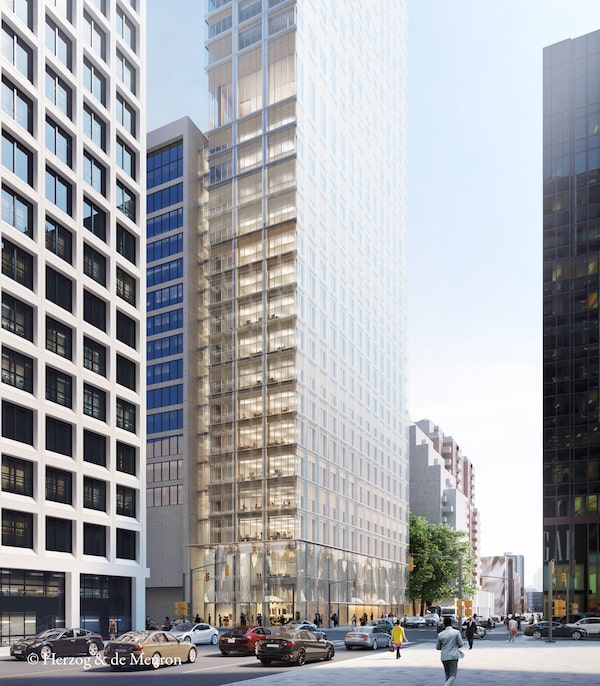
A view of the proposed tower at Bay and Bloor, seen from the north.Herzog & de Meuron/Supplied
A new supertall tower by world-leading architects could reshape the downtown Toronto skyline.
A partnership of two Dutch real estate companies is proposing an 87-storey office-and-residential tower at the northwest corner of Bloor and Bay Streets, designed by Swiss architects Herzog & de Meuron. At 324 metres, if built today, it would become the tallest building in Canada.
“The tower defines the northern edge of the downtown area and provides a landmark in the urban grid,” said Wim Walschap, a partner at Herzog & de Meuron (HdM) who is leading the design. “It is a very direct response to the site and the city around it.”

Architects Herzog & de Meuron are proposing a double glass skin for the building, with operable windows on the inside façade that open onto an air space between the two layers of glass.Herzog & de Meuron/Supplied
The design is for a tower that would be not just among the tallest but also likely the thinnest high-rise in Toronto; its upper floors are just 7,300 square feet in area. It would contain two floors of retail, 13 floors of office space, 71 floors of residential condominium units ranging from one-bedrooms to penthouses and then a restaurant at the top.
The announcement comes at a time when the markets for high-rise residential and office space face uncertainty, thanks to COVID-19 and expectations of a major recession. Cyndi Rottenberg-Walker, of Toronto-based planning consultancy Urban Strategies Inc., who is consulting on the project, said the development has been in active preparation for several months. “They have put serious investment into hiring some of the best architects anywhere," she said. “It’s not being taken lightly.”
The project is now seeking planning approval from the City of Toronto. If approved, it would be the first building in Canada by HdM, highly regarded architects who designed the Bird’s Nest stadium for the Beijing Olympics and the Tate Modern gallery in London. And they are the design architects for the proposed new home of the Vancouver Art Gallery, announced in 2015.
HdM won the Pritzker Architecture Prize, the most prestigious award in the field, in 2001.
The architects, with local firm Quadrangle, are proposing a “double skin” façade of glass. An outer layer would provide shading and allow fresh air in selected places; an inner façade would have windows that can be opened, lined with built-in wooden shutters that can be controlled by the occupants of the offices and homes.
The building would replace a 12-storey office tower at 1200 Bay St., built in 1968, in the Yorkville neighbourhood. That building is owned by a Canadian subsidiary of ProWinko; they are partnering on the new tower proposal with Kroonenberg Group. Both companies are based in the Netherlands, and are real estate investors and developers active principally in Europe. This is the first development project in the city for both companies.

The project would replace an existing office building at the northwest corner of Bloor and Bay Streets.Herzog & de Meuron/Supplied
The site sits next to 80 Bloor St. W, another midcentury office building whose owners, privately held Krugarand Corp., are proposing to replace it with a 79-storey tower. The architects for the Kroonenberg proposal are suggesting an integrated development, in which the two projects would share underground facilities including loading and servicing. This would allow the lane behind the buildings to be pedestrianized.
They also suggest that the office building to the north – on city-owned land – could be demolished and turned into an extension of the adjacent park. This possibility is part of existing city plans for Yorkville.
City urban-design officials are engaged in attempts to comprehensively plan this area, which has been attracting intense development for a decade.
The tower, like all major buildings in Toronto, would require amendments to planning policies that typically take years. It also would reshape the city’s urban design policy for this area, which calls for a “height peak” at the corner of Bloor and Yonge Streets and towers that become shorter as they move away from that point. But Bloor and Bay "is one of the most important corners in the city,” Ms. Rottenberg-Walker said. “Exceptional sites and exceptional circumstances sometimes need exceptions to typical planning policy.”